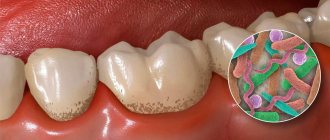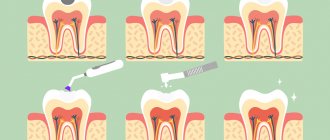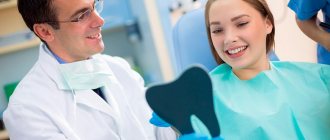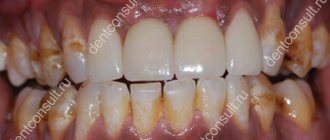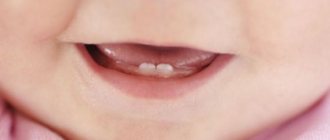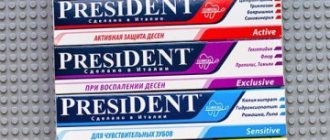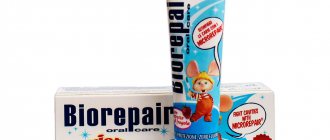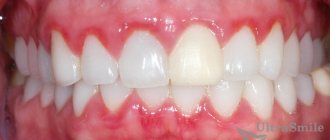In addition to the refreshing and cleansing effect, toothpastes can have a therapeutic or preventive effect. Some help reduce gum sensitivity, others help prevent tooth decay. When purchasing, study the composition and purpose of a specific care product. We'll tell you which toothpastes for caries prevention are popular.
In this article
- The best toothpaste for caries: how to choose
- The best toothpastes for caries prevention
To understand which toothpaste to use to protect against caries, you need to know how this disease develops. Dental caries is a slowly developing pathological process that causes destruction of enamel and hard tooth tissue - dentin.
The main cause of caries is poor oral hygiene, which leads to the proliferation of cariogenic bacteria. The waste products of these microbes, that is, toxins and harmful acids, corrode the enamel and penetrate inside the tooth. This process is accompanied by demineralization—the loss of various minerals and salts by bone tissue and enamel.
The development of caries occurs in several stages. At the initial stage, it can be stopped with the help of remineralization. Dentists prescribe special dental gels and toothpastes with calcium, fluoride and other minerals to the patient. These products can be used not only for treatment, but also as a preventive measure for caries. Some people are predisposed to this disease. But if you maintain hygiene and brush your teeth with medicated paste, the likelihood of caries is significantly reduced. At the same time, you need to understand that only a doctor, and not hygiene products, can completely cure the pathology. Some toothpastes that are marketed as medicinal can only be used for their intended purpose.
Will floss prevent dental caries?
A recent New York Times article[] questioned the benefits of dental floss.
A 2011 study[] found that flossing in addition to brushing reduces the risk of gum disease. And not too much, since most people don’t floss their teeth thoroughly enough.
But in the fight against enamel destruction, thread is not a help at all. There is still no evidence that regular flossing reduces the risk of tooth decay.
In the beginning there was sand and chalk
Toothpaste and brush are everyday things with which our day begins and ends. However, they were once a real luxury. The ancient Egyptians were the first to think about oral hygiene and began to use sand, ash, ground stones and animal horns as a cleaning agent, and their own finger replaced the brush. In the 4th century BC. The great healer Hippocrates recommended using mixtures of pumice with the addition of wine vinegar, which are more gentle on tooth enamel, to prevent dental diseases. At the end of the 18th century, little had changed. For example, the British brushed their teeth with powders that included crushed brick, crushed bark and coal chips.
The prototype of modern toothpaste was invented by Americans in the 19th century. This time there were no stones or ash. Teeth cleaning products were a mixture of chalk powder, neutral soap and aromatic additives. It was only in 1873 that Colgate released the first toothpaste in glass jars, which replaced tubes two decades later. They were invented by dentist Washington Sheffield of New London. But Colgate beat the inventor by quickly registering a patent for itself. An interesting fact is that in Russia, most people at that time continued to brush their teeth with chalk-based powder, and only in the 50s it became possible to buy a familiar tube of toothpaste in stores.
Do I need a dental scan?
American dentists recommend having your teeth x-rayed every year. Austin Frakt, a health economist, reviewed[] medical studies and concluded that such reinsurance is unwarranted. Cavities in the tooth form more slowly—over 2–3 years.
In Russia, preventive x-rays are not so popular. But computed tomography is suggested to be done regularly. You should also not agree to this expensive service more often than once every couple of years.
Modern treatment of caries
Thanks to the constant improvement of techniques, today the diagnosis and treatment of dental caries is carried out at a high level, which allows for maximum preservation of healthy tissue. In addition, in situations where just a few years ago advanced caries led to mandatory tooth extraction, today tooth-preserving operations are performed. Among them are the following.
- Resection:
treatment of tooth root caries by removing the apex of the root. - Root amputation:
removal of the damaged root part of a two-rooted or three-rooted tooth. - Coronoradicular separation:
separation of tooth roots. It is carried out when caries has affected the tooth in the area of root branching. - Hemisection:
removal of the damaged part of a multi-rooted tooth and the adjacent crown area.
Which toothpaste is more effective?
The good news is that brushing your teeth is still beneficial. But to prevent the development of caries, the paste must contain fluoride. A study of the results of dental examinations of children aged 5 to 16 years []confirmed the effectiveness of the use of this mineral for the prevention of caries and tooth loss. Moreover, it is better to brush your teeth with fluoride paste twice, not once: the positive effect will be more noticeable.
True, fluoride paste does not help against gingivitis and plaque on teeth. But it really protects against enamel destruction.
Pastes for the prevention of dental caries
Toothpastes for the prevention of caries are recommended for increased susceptibility to the formation of caries bacteria, as well as as restorative therapy after teeth whitening. They saturate dental tissues with useful minerals, prevent the growth of carious bacteria, and also fight the formation of plaque. To strengthen teeth, fluoride compounds are added to such pastes. It is contained in such pastes as “Day and Night” Swiss Smile, Enzycal 950 CURAPROX, Mirafluor C Miradent, “Power of a Smile” Jason and others. Fluorine is an important microelement, since it is the one that participates in the metabolism of calcium, and, therefore, ensures its presence in the enamel. But it is worth remembering that it is extremely toxic, so its amount entering the body should not exceed the established norm. People living in areas with fluoride-saturated water (more than 1.2 mg/l) are advised to use fluoride-free toothpaste. You can find out about the fluoride content in the water in your area by calling the nearest Sanitary and Epidemiological Station.
Toothpaste
Theodent Classic
Which toothbrush is better
Electric toothbrushes are many times more expensive than regular ones. But it does seem to make sense in terms of plaque and gingivitis control.
Researchers compared the teeth of adults and children who used electric and regular toothbrushes. Within a month, it turned out that among representatives of the first group, plaque formation decreased by 11%, and after three months - by 21%. After a month of using electric toothbrushes, the incidence of gingivitis decreased by 6%, and after 3 months - by 11%.
Models with a rotating head cope best with plaque.
Types of caries according to severity
Initial caries
Characterized by a change in the color of the enamel: the so-called white spot caries. Does not cause discomfort to the patient.
Superficial caries
Characterized by the appearance of dark spots on the enamel. The affected tooth may react weakly to cold, sour or sweet foods for a short time.
Average caries
Characterized by destruction of dentin. Painful sensations to external stimuli are more pronounced and last longer.
Deep caries
Characterized by damage to a large area of tooth enamel and dentin. The pain does not go away without the use of analgesics.
Is professional teeth cleaning necessary?
Some dentists recommend polishing and grinding your teeth, or professional cleaning, twice a year. However, this procedure has a number of contraindications: allergic reactions to the medications used, enamel sensitivity, bleeding gums.
In 2005, eight studies[] were conducted on the effects of professional dental cleanings on dental health. None of them even confirmed the safety of this procedure, let alone the need to do it regularly.
Pastes "Asepta"
The Asepta series has a wide selection of medicinal pastes that help solve various problems:
- ASEPTA ACTIVE provides teeth with comprehensive protection, helps reduce the number of pathogenic microbes and eliminate inflammatory processes in the oral cavity.
- ASEPTA SENSITIVE reduces tooth sensitivity and treats gums.
- "ASEPTA PLUS" REMINERALIZATION restores thinned enamel and protects gums from inflammation.
Regular use of Asepta products can reduce bleeding gums and improve dental health.
Why do you need interdental brushes?
In 2015, a review of seven studies was published in which 354 patients brushed their teeth in three ways:
- only with a brush;
- brush and floss;
- brush and brushes.
Only once did scientists note that additional cleaning with a brush had advantages over brushing. But the evidence cannot be considered rigorous, since we are talking about a superficial study: the effect has not been analyzed in the long term. The same goes for comparing brushes and dental floss.
There is not enough data yet to draw conclusions about the benefits of brushes for interdental spaces.
What to look for when choosing?
Remember that comprehensive dental treatment will eliminate all problems in the oral cavity. The main thing is to contact an experienced doctor who uses the latest equipment and uses modern technologies. The choice of hygiene product is no less important. The drug must not contain harmful ingredients. You should choose a product carefully, taking into account its composition. It's difficult to navigate through the huge assortment. The variety of brands and types confuses the buyer. To avoid harming yourself, you need to consult a dentist.
After all, the patient may not be suitable for high abrasive properties or the presence of fluoride. Therefore, the appropriate remedy will be different for everyone, depending on the pathological situation and the characteristics of the body. The general selection rules are:
- The remedy should facilitate therapy and prevent the recurrence of the disease.
- Calcium compounds and fluorides strengthen the enamel. They are recommended for mineral deficiencies to eliminate the vulnerability of crowns.
- To prevent the proliferation of pathogenic microbes in the oral cavity, antiseptics such as chlorhexidine, as well as the enzymes lysozyme and lactoperoxidase, are included in the preparations.
- A special natural protein that contains iron is lactoferrin.
- Products with hydrogen census and papain help remove soft plaque, which inhibits the formation of stones.
Moderate abrasiveness does not allow the crowns to be overloaded. Such resources contain potassium ions. This reduces the vulnerability of nerve fibers in dentin. Strontium chloride and sodium fluoride help reduce the lumen of the tubules, which protects the sensory nerves. Brands of gels and pastes with herbal ingredients are prescribed for damaged and sore gums. Soft tissue therapy allows you to fully clean the entire surface of the crown, capturing the cervical area, where pathogenic bacteria most often accumulate.
How often should you visit the dentist?
In 2013, scientists analyzed[] data from medical examinations of 36,000 children. With regular preventive examinations, the likelihood of subsequent requests for treatment was indeed lower. But preventive examinations are economically justified no more than once a year.
Further research showed[] that it was not preventive examinations as such that had a positive effect, but the use of dental sealants. Dental sealants are coatings that are applied to the chewing surfaces of teeth to protect them. This procedure is most effective for children when the teeth are not yet damaged.
But sealants, when applied correctly, last from three to five years. Therefore, in this case, you can get by with fewer visits to the dentist.
Main components of hygienic pastes
The main components of hygienic pastes are abrasive particles, foaming agents, flavoring additives and sweeteners.
Any toothpaste contains a certain amount of abrasive particles , which increase the friction of the brush on the teeth and improve the mechanical cleaning of the enamel. Depending on the size and number of these particles, pastes come in different abrasiveness . Those pastes that are called whitening, in fact However, you should not get carried away with such pastes, because the abrasive they contain can erase not only plaque, but also part of the tooth enamel, damaging it and causing increased tooth sensitivity. You can use all whitening pastes only for a course of 2–4 weeks, then take a break for at least a month, after which, if necessary, the course can be repeated. For children and patients with sensitive enamel, as well as those with areas of destruction on the teeth (wear, wedge-shaped defects, enamel erosion, etc.), whitening pastes are completely contraindicated.
In addition, most toothpastes contain foaming agents that promote the appearance of foam when brushing your teeth. Most often this is inexpensive sodium lauryl sulfate (SLS). A side effect of sodium lauryl sulfate is an unpleasant feeling of dry mouth after brushing your teeth. In addition, it can cause irritation of the oral mucosa and an allergic reaction. Therefore, it is better that the paste does not contain sodium lauryl sulfate (the tube is marked “does not contain SLS” or “SLS free”). Other foaming agents have fewer side effects, but are more expensive, so their inclusion in the composition increases the cost of the toothpaste.
Flavoring additives can
The sweeteners contained in toothpaste can also be different. Most often it is sorbitol, which The best sweetener for toothpastes is xylitol; in addition to its sweet taste, it also has an antimicrobial effect.
In addition to these basic components, toothpaste may also contain medicinal components.
